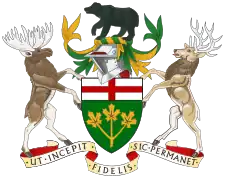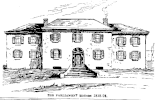Legislative Assembly of Upper Canada | |
|---|---|
 The First Ceremonial Mace of Upper Canada The First Ceremonial Mace of Upper Canada | |
| Type | |
| Type | |
| History | |
| Founded | 1791 |
| Disbanded | 1841 |
| Preceded by | none |
| Succeeded by | Legislative Assembly of the Province of Canada |
| History of Ontario | ||||||||||||
|---|---|---|---|---|---|---|---|---|---|---|---|---|
 | ||||||||||||
| Timeline | ||||||||||||
|
||||||||||||
| Upper Canada Topics | ||||||||||||
| Province of Canada Topics | ||||||||||||
| Province of Ontario topics | ||||||||||||
|
| ||||||||||||
The Legislative Assembly of Upper Canada was the elected part of the legislature for the province of Upper Canada, functioning as the lower house in the Parliament of Upper Canada. Its legislative power was subject to veto by the appointed Lieutenant Governor, Executive Council, and Legislative Council.
The first elections in Upper Canada, in which only land-owning males were permitted to vote, were held in August 1792.
The first session of the Assembly's sixteen members occurred in Newark, Upper Canada on 17 September 1792. Shortly before the capital of Upper Canada was moved to York in 1796 the Assembly was dissolved and reconvened for twelve more sessions between 1797 and 1840 in modest buildings in the new capital. Members continued to be elected by land-owning males to represent counties and the larger towns.
During the War of 1812, American troops set fire to the buildings of the Assembly.
Political divisions

Following the war, the executive and legislative councils became increasingly dominated by the Family Compact, a clique of wealthy individuals led primarily by John Strachan (a member of the powerful Executive Council of Upper Canada), which emerged in 1815. The compact was deeply opposed to American republicanism and favoured full establishment for the Anglican church in Upper Canada. Their increasingly authoritarian style of governance and disregard for the will of the Legislative Assembly led to demands for government that was more responsible to the people and eventually the Upper Canada Rebellion of 1837. Opposing the Family Compact were initially an assortment of anti-establishment members, but it did not gain strength until a more formal group of reformers emerged, initially led by William Warren Baldwin starting 1820s and then by William Lyon Mackenzie in the 1830s.
The 1840 Act of Union united Upper and Lower Canada into the single Province of Canada and, from this point until Confederation in 1867, a joint parliament was held for the united provinces.
List of parliaments
- 1st Parliament of Upper Canada 1792–1796
- 2nd Parliament of Upper Canada 1797–1800
- 3rd Parliament of Upper Canada 1801–1804
- 4th Parliament of Upper Canada 1805–1808
- 5th Parliament of Upper Canada 1808–1812
- 6th Parliament of Upper Canada 1812–1816
- 7th Parliament of Upper Canada 1817–1820
- 8th Parliament of Upper Canada 1821–1824
- 9th Parliament of Upper Canada 1825–1828
- 10th Parliament of Upper Canada 1829–1830
- 11th Parliament of Upper Canada 1831–1834
- 12th Parliament of Upper Canada 1835–1836
- 13th Parliament of Upper Canada 1837–1840
Speakers
| Speaker | Term | Parliament |
|---|---|---|
| Captain John McDonell | 1792–1796 | 1st |
| Sir David William Smith, 1st Baronet | 1796–1800 and 1801–1804 | 2nd and 3rd |
| Samuel Street | 1800–1801 and 1809–1812 | 2nd and 5th |
| Alexander Macdonell | 1805–1808 | 4th |
| Allan McLean | 1813–1820 | 6th and 7th |
| Levius Peters Sherwood | 1821–1824 | 8th |
| John Wilson | 1825–1828 | 9th |
| Marshall Spring Bidwell | 1829–1830 and 1835 | 10th and 12th |
| Archibald McLean | 1831–1834 and 1836 | 11th and 12th |
| Allan MacNab | 1837 and 1837–1840 | 13th |
| Henry Ruttan | 1837 | 13th |
Changing loyalties
A few members of the legislature eventually left Canada. Some left Canada to join the United States Army during the War of 1812. Some were involved in the Rebellion of 1837 and other just simply abandoned Canada. Most moved to the United States, some left for Great Britain.
| Name | Born | Died | Reason for leaving Canada |
|---|---|---|---|
| Joseph Willcocks | Palmerstown, Ireland, Great Britain | Fort Erie, Ontario, Canada | Fled Canada – organized Canadian Volunteers within United States Army, rank as Lieutenant Colonel; died in Canada and re-buried in Buffalo, New York |
| William Macomb | Northern Ireland, Great Britain | Fort Detroit, Upper Canada | Detroit was part of Upper Canada before 1796; died in Detroit |
| Hugh McDonell | Aberchalder Lodge, Scotland | Florence (March of Tuscany, Austrian Empire) | Left Canada to serve as British diplomat; died in Italy |
| Robert Thorpe | Dublin, Ireland, Great Britain | London, United Kingdom | Forced to leave Canada – subdsequently served as chief justice and judge of the Vice-Admiralty Court in Sierra Leone 1808–1811; died in England |
| Benajah Mallory | Vermont (Thirteen Colonies) | Lockport, New York, United States | Fled Canada during War of 1812 and subsequently served in Canadian Volunteers with United States Army, died in NY |
| Abraham Markle | Ulster County, Province of New York | Terre Haute, Indiana, United States | Left Canada during War of 1812 and joined Canadian Volunteers with United States Army as a Major; died in the US |
| Marshall Spring Bidwell | Stockbridge, Massachusetts, United States | New York, NY | Forced to leave Canada due in involvement in 1837 Rebellion, became New York State lawyer, died in NYC |
| Peter Perry | Ernestown, Upper Canada | Saratoga Springs, New York, United States | Died after visiting Bidwell in the US |
| Hiram Norton | Vermont, United States | Lockport, Illinois, United States | Fled Canada due to involvement in 1837 Rebellion; became a flour mill owner/operator; died in US |
| Charles Duncombe | Connecticut, United States | Hicksville, California, United States | Fled Canada due to involvement in 1837 Rebellion, became California State Assemblyman 1859 and later as a county representative of the Sacramento County 1863–1867; died in California |
| William Lyon Mackenzie | Dundee, Scotland | Toronto, Province of Canada | Fled Canada due to involvement in 1837 Rebellion, became US citizen and later returned to Canada 1849; died in Toronto |
| Jesse Ketchum | Spencertown, New York, United States | Buffalo, NY, United States | Retired and moved from Canada to Buffalo, New York in 1845 and died in there in 1867 |
| Henry Yager | Claverack, New York, United States | Dane County, Wisconsin, United States | Left Canada with family as dairy farmer in Dane County, Wisconsin and died there |
| Robert Alway | Gloucester, Gloucestershire, England, Great Britain | Republic of Texas | Fled Canada due to involvement in 1837 Rebellion and died shortly after arriving in Texas |
| David William Smith | Salisbury, England | Alnwick, Northumberland, England | Left Canada and return to England in 1804 and became a property manager; died in England |
Buildings housing the Legislative Assembly
 The first Parliament of Ontario (Upper Canada) in Toronto (York) on Front Street at Parliament Street, pre-1812
The first Parliament of Ontario (Upper Canada) in Toronto (York) on Front Street at Parliament Street, pre-1812 The second Parliament of Ontario (Upper Canada) in Toronto (York), 1818–1824
The second Parliament of Ontario (Upper Canada) in Toronto (York), 1818–1824 The third Parliament Building in York, 1832, on Front Street between Simcoe and John St.
The third Parliament Building in York, 1832, on Front Street between Simcoe and John St.
- Navy Hall at Newark (1792)
- First (1793–1813) and second (1820–1824) Parliament Buildings of Upper Canada at York
From 1824 to 1832, the Assembly sat at temporary locations due to the fire that destroyed the second home:
- Residence of the Chief Justice of Upper Canada (1824-1829)
- Old York County Court House on King between Toronto and Church Streets (1829–1832)
- Ballroom of York Hotel at York – one session 1813
- York General Hospital (1824–1829)
- Third Parliament Buildings of Upper Canada (1832–1840)
See also
References
- Handbook of Upper Canadian Chronology, Frederick H. Armstrong, Toronto : Dundurn Press, 1985. ISBN 0-919670-92-X
External links
- James G. Chewett, "The Upper Canada almanac, and provincial calendar, for the year of Our Lord 1827: being the third after bissextile or leap year, and the eighth year of the reign of His Majesty [King G]eorge the Fourth ..." (York (Toronto): Robert Stanton, 1827), 76, ii pp.
- James G. Chewett, "The Upper Canada almanac and astronomical calendar for the year of Our Lord 1828: being bissextile or leap year and the ninth year of the reign of His Majesty King George the Fourth ..." (York (Toronto): Robert Stanton, 1828), 76, ii pp.
- James G. Chewett, "The Upper Canada almanac, and provincial calendar, for the year of Our Lord 1831: being the third after bissextile, or leap year, and the second year of the reign of His Majesty King William the Fourth ..." (York (Toronto): Robert Stanton, 1831), 103, ii pp.
- Government of Ontario site